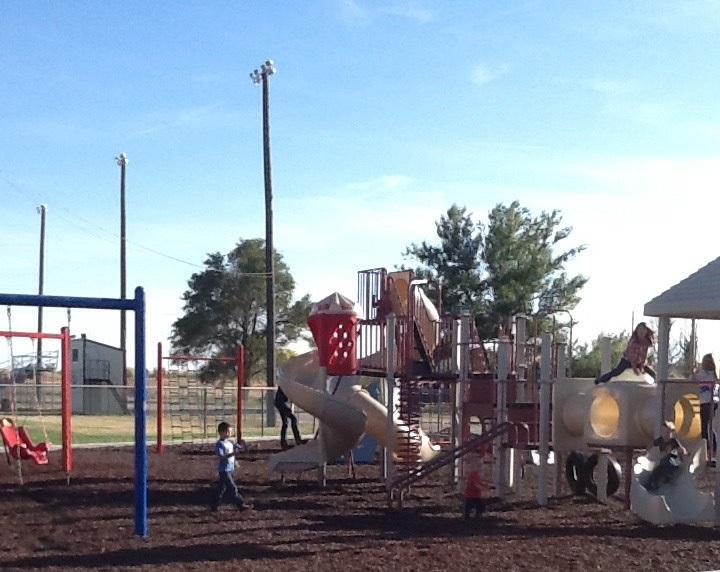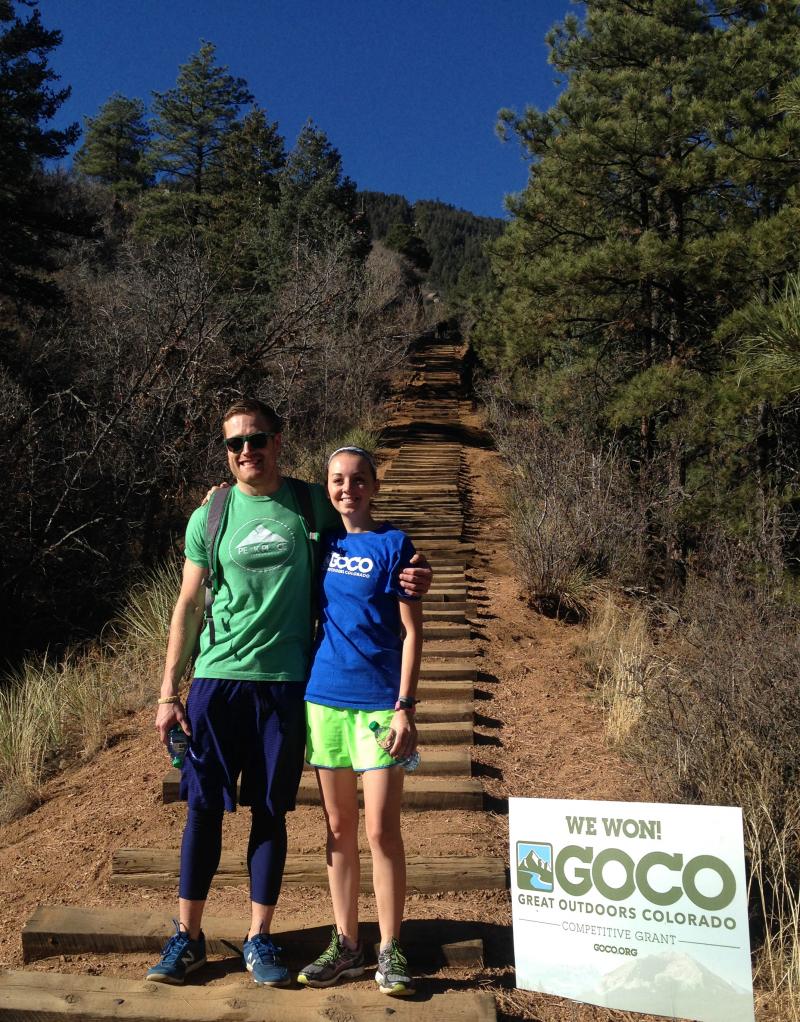GOCO made our February leap day really count, with seven exciting projects closing this month! We’re most excited about this batch of projects because they show off the wide variety of things GOCO funds. From planning grants and studies to discover why kids aren’t getting outside, to exercise parks and the state’s most infamous (and grueling) trail, we had it all in February!
First up is the newly improved park and playground in Ordway, a small town west of Pueblo. The Town of Ordway and Crowley County School District RE-IJ joined forces to update the school playground and Conestoga Park, where equipment more than two decades old was starting to pose a safety problem.
The town and school district leveraged funding from the Colorado Health Foundation to match the $288,651 grant from GOCO, enabling them to replace unsafe playground equipment with new structures for kids of all ages, build accessible walkways, and to install a turf field, safer rubber mulch, and fitness-themed playground equipment. Ordway will be hosting a grand opening later this spring, so keep your eye out for more event details on the GOCO Facebook page!
 Deer Trail may be just another sign you whiz past on your east-bound drive on I-70, but this small rural town was brimming with enthusiasm to overhaul their aging elementary school playground. A $100,000 GOCO grant enabled Deer Trail Elementary to continue the momentum built during their Active Schoolyards Active Minds project, which helped discover what students wanted their playground to look like. Existing equipment was last updated as far back as 1971, despite the fact that the playground was a natural gathering place for the entire community; Deer Trail estimated that 75% of the community used the old playground, even in its deteriorating condition.
Deer Trail may be just another sign you whiz past on your east-bound drive on I-70, but this small rural town was brimming with enthusiasm to overhaul their aging elementary school playground. A $100,000 GOCO grant enabled Deer Trail Elementary to continue the momentum built during their Active Schoolyards Active Minds project, which helped discover what students wanted their playground to look like. Existing equipment was last updated as far back as 1971, despite the fact that the playground was a natural gathering place for the entire community; Deer Trail estimated that 75% of the community used the old playground, even in its deteriorating condition.
Neither the school nor the community had the financial means to build a new playground on their own, but with GOCO funding the project came to life. Accessibility was improved with resurfaced asphalt, a shaded outdoor classroom was constructed, and enough equipment was installed to eliminate the once common lines for the lone swing set.
Costilla County in the San Luis Valley has a poverty rate double the state average, a senior population double the state average, no rec center in the southern part of the county, and no public transportation. In a rural area where gym memberships are not a financial option, residents were literally taking to the streets to try to get some daily activity in on their lunch breaks.
The county wanted to install fitness equipment at the San Luis/Costilla County Health and Human Services Complex, where it would be centrally located, user-friendly, and free to anyone who wanted to use it. Youth were already benefitting from a newly constructed school building, but adults were still in dire need of better opportunities to exercise. A $166,030 GOCO grant helped build six stations of fitness equipment, with four additional individual pieces of equipment. Youth Corps crews helped prepped the site for construction and helped with the installation, making this project a true community-driven effort to improve health and get outside.
Before a park comes a plan, but expert advice to form a master plan doesn’t come free. GOCO awarded the Town of Saguache a $29,575 planning grant to help the town create a framework for the development of Vista Grande Park. GOCO also funded the acquisition of the 220-acre piece of parkland in 2009, and Saguache returned for funding to engage the community to determine how best to move forward.
Think of a planning grant as the ultimate Soccer Mom – they think of EVERYTHING. Not just the fun stuff like what sort of trails and playgrounds a park should have, but how to not disturb neighbors (human or animal), how to make sure people stay safe at the park, how to ensure the park it isn’t overused…the list goes on! A planning grant makes sure all the bases are covered.
With plans for an archery range, campground, environmental education, a trail system, outdoor programming and more, Saguache has a clear vision for their small corner of the San Luis Valley over the next three years that we’re looking forward to watch come to life!
The infamous Incline in Manitou Springs is a great example of a planning process come to life. While the Incline hosted its grand re-opening in December 2014, now that all the i’s have been dotted and t’s have been crossed, we’re celebrating this incredible project all over again. The City of Colorado Springs took on the impressive task of refurbishing the Incline, which had received zero maintenance since 1990. Given the punishing incline of its 2,000-foot climb, Mother Nature had taken its toll on this much-beloved trail.
With over 1,000 people taking on the Incline every day in the summer, Colorado Springs described it as, “Colorado’s most popular and least sustainable trail.” Nearly a quarter of the trail was critically unsustainable, and the City of Colorado Springs began to tackle a $1.2 million project to make the Incline safe again. $350,000 from GOCO, the maximum available through our LPOR grant program and the largest amount awarded to the project, helped Colorado Springs install 22 new drainage structures to mitigate erosion and replace unsafe railroad ties. GOCO staff took on the Incline at its grand opening, and we can attest that it’s still every bit as rugged as it should be.
 Rio Grande Farm Park in Alamosa opened to the public in 2015, and is another project we're happy to re-celebrate as we close things out on the administrative side. The Trust For Public Land partnered with Colorado Open Lands and the San Luis Valley Local Foods Coalition to conserve a 38-acre parcel of land in downtown Alamosa. The park was operating on a handshake agreement as a community garden, but residents wanted to make it official and make sure the park would be there for generations to come. Purchasing a conservation easement to conserve Rio Grande Healthy Living Park meant it would be a permanent green fixture in the Alamosa community. This project is a great example of how land conservation benefits people, not only giving them a place to play outside but also to grow healthy foods. Click here to read a blog post featuring this project, funded by a $254,000 open space grant from GOCO.
Rio Grande Farm Park in Alamosa opened to the public in 2015, and is another project we're happy to re-celebrate as we close things out on the administrative side. The Trust For Public Land partnered with Colorado Open Lands and the San Luis Valley Local Foods Coalition to conserve a 38-acre parcel of land in downtown Alamosa. The park was operating on a handshake agreement as a community garden, but residents wanted to make it official and make sure the park would be there for generations to come. Purchasing a conservation easement to conserve Rio Grande Healthy Living Park meant it would be a permanent green fixture in the Alamosa community. This project is a great example of how land conservation benefits people, not only giving them a place to play outside but also to grow healthy foods. Click here to read a blog post featuring this project, funded by a $254,000 open space grant from GOCO.
The City of Pueblo brought it home this month by wrapping up their Plug Into Nature gap and opportunity analysis to figure out why kids in low-income neighborhoods weren’t getting outside. Pueblo suffers from higher than average childhood obesity rates along with a host of other health issues; the city ranks 54 out of 59 Colorado communities for health outcomes.
Pueblo wants to turn this outlook for kids around, and their insight is already paying off. They were recently selected as a Tier 2 Community for our Inspire Initiative; that planning process will be informed by the data collected in this study, which identified barriers to getting outside, engaged the community to find out what they want to do outdoors, and created recommendations to move forward. We’re excited to see how Pueblo leverages this information to apply for implementation funding as part of Inspire in 2017!
We’ve got more exciting projects on the horizon for March, so stay tuned! You can tide yourself over with our January update about a school track that might just improve the health of an entire community. Also coming down the pike is our April board meeting in Limon, where the board will decide on funding for Local Park and Outdoor Recreation grants.
Great Outdoors Colorado (GOCO) invests a portion of Colorado Lottery proceeds to help preserve and enhance the state’s parks, trails, wildlife, rivers, and open spaces. GOCO’s independent board awards competitive grants to local governments and land trusts, and makes investments through Colorado Parks and Wildlife. Created when voters approved a Constitutional Amendment in 1992, GOCO has since funded more than 4,700 projects in urban and rural areas in all 64 counties without any tax dollar support.
